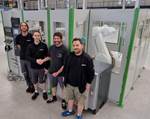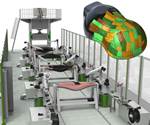Fuji Industries purchase brings FPP-based Samba Pro PV to Japan
Dedicated to the production of hydrogen pressure vessel reinforcements, Cevotec’s specialized FPP system will be made accessible to Japanese industry through Fuji, including aerospace and composites research.
Samba Pro PV system. Photo Credit: Cevotec
Fiber patch placement (FPP) provider Cevotec (Munich, Germany) has introduced the first FPP production system to the Japanese market. (Kobe), a specialized Japanese trading company with in-depth knowledge and experience in industries such as aerospace and high-tech equipment, has ordered Cevotec’s Samba Pro PV system. The first FPP system on Japanese soil will be primarily dedicated to advancing hydrogen (H2) tank production with dome reinforcements, thereby reducing the weight, cost and environmental footprint of composite tanks.
Fuji Industries placed the order for Cevotec’s FPP-based Samba Pro PV after its preview at JEC 2023. The strategic move reflects the company’s commitment to advancing Japan’s composite production capabilities and support the local industry with advanced, state-of-the-art technology solutions.
“With fiber patch placement, it is possible to reinforce the dome areas of Type IV hydrogen tanks which leads to sizable material savings,” Junji Yamada, president and CEO of Fuji Industries, says. “This technology has the potential to establish a new standard in composite tank production — it enables us to support our customers with new automation options that they need to stay competitive.”
In order to enable broad industrial and scientific engagement with the FPP system, Fuji Industries is planning on placing the system at a strategic R&D location that is accessible to relevant industry companies in aerospace and H2 and is well integrated in the Japanese composites research ecosystem.
The Samba system configuration is mainly suited to the production of dome reinforcements for composite pressure vessels. It features a temperature-controlled automated material cutting and feeding unit and pick-and-place robot with six axes for high geometrical flexibility. The robot cooperates with a length-adjustable rotational axis in which the vessel liner is mounted. Suitable liner dimensions are 800-3,000 millimeters in length and 300-1,000 millimeters in diameter. The system features a vision system for quality inspection and position check. By placing stationary layup tools in free spaces of the FPP cell, the range of applications can also be extended to aerospace and automotive applications, Cevotec says.
“The expected fiber demand for H2 tanks will likely outgrow available fiber supply in the next 5-10 years,” Thorsten Groene, CEO and co-founder of Cevotec, says, underlining the strategic relevance. “Technologies like FPP that bring double-digit material savings become strategically important for staying competitive long-term in the global market.”
Related Content
-
Composites end markets: New space (2025)
Composite materials — with their unmatched strength-to-weight ratio, durability in extreme environments and design versatility — are at the heart of innovations in satellites, propulsion systems and lunar exploration vehicles, propelling the space economy toward a $1.8 trillion future.
-
Composite pressure vessels enable future energy storage
Q&A between Hexagon Purus, Infinite Composites and Hyosung USA delves into the future of H2 storage, including scalability and production goals, materials and application trends and other dynamics.
-
Infinite Composites: Type V tanks for space, hydrogen, automotive and more
After a decade of proving its linerless, weight-saving composite tanks with NASA and more than 30 aerospace companies, this CryoSphere pioneer is scaling for growth in commercial space and sustainable transportation on Earth.






